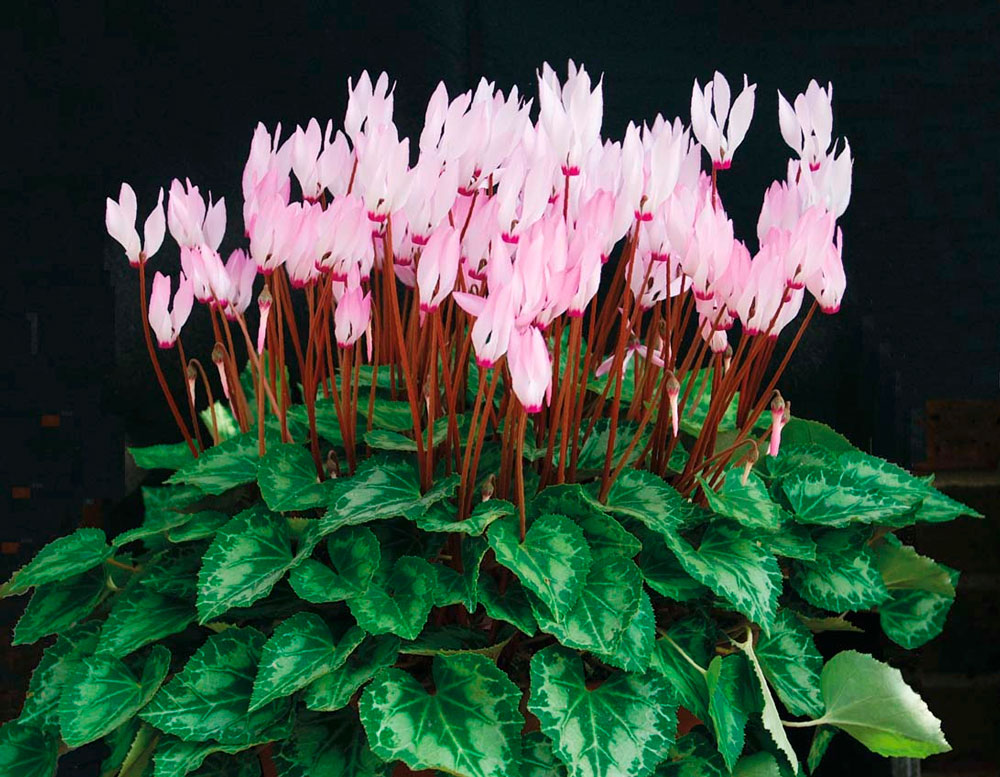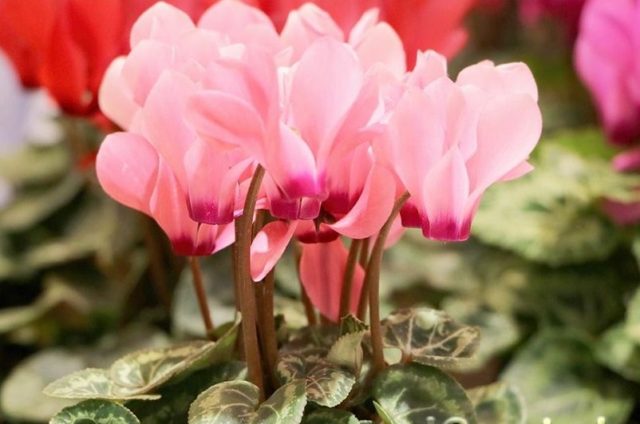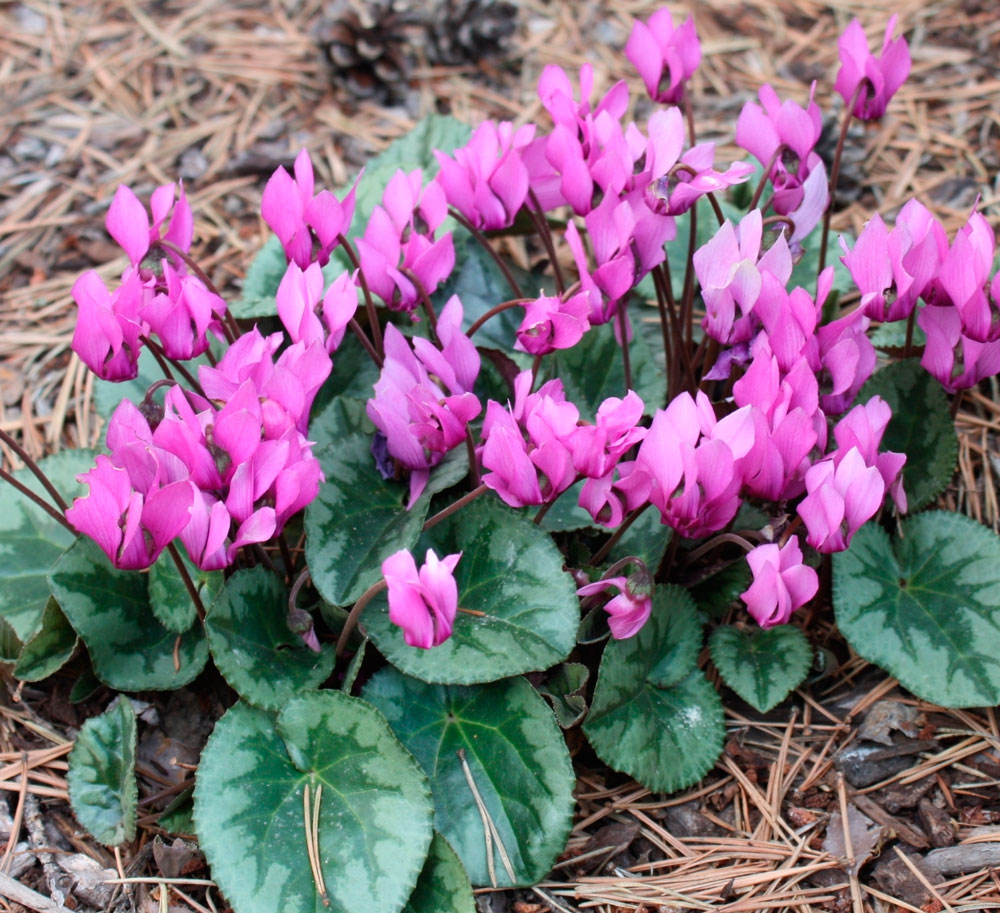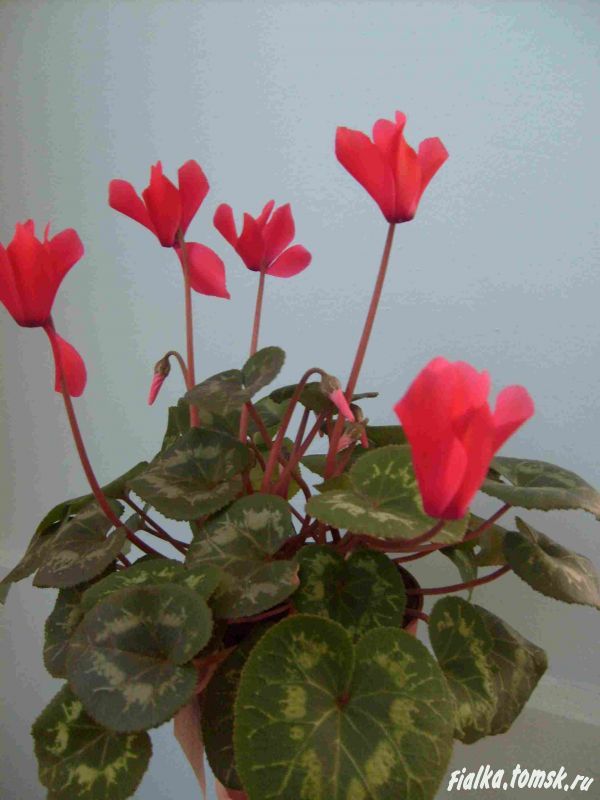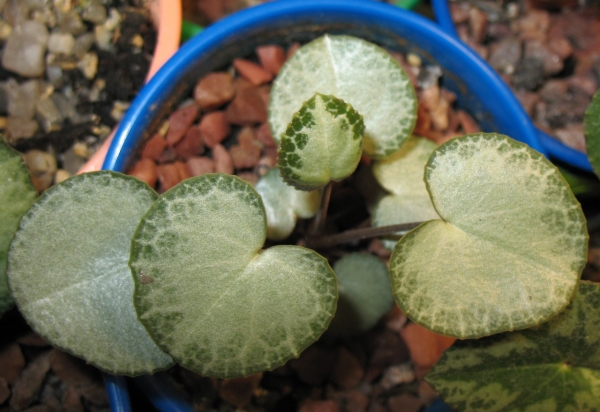Peculiarities
The flower grows in mountainous areas, mainly among forests and shrubs. The most common growing height is the lower and middle altitudinal belts.
Cyclamen is a perennial plant with individual flower appearance. The shape of the petal, which is slightly turned in relation to the center, tapers sharply towards the base. The features of the shape and color combinations of a flower can be influenced by external factors: the place of growth, climate, soil composition, and others.
The average period for the appearance of the first flowers is early April. In recent years, due to changes in the climatic characteristics of the localities, the beginning of flowering has shifted towards winter.


The aerial part of the cyclamen dies off completely by the middle of summer. During the subsequent period of growth, new shoots, leaves, buds appear. In this form, the plant hibernates, after which the cycle repeats.
During blooming, cyclamen consumes a lot of moisture. This need is easily met during early spring. After the end of flowering, the plant falls into suspended animation and practically does not consume any resources. This allows him to easily endure the summer heat and drought.
Torn off, with proper care, cyclamen can retain its proper appearance for 10-12 days.
Flower tubers take root well in captivity. There are artificially bred varieties of this plant, endowed with pronounced decorative external characteristics. With a clear understanding of the properties of this plant, it can be grown independently and even used for medicinal purposes.

How to plant?
Ornamental cyclamen can be purchased at any flower shop. In this case, the plant can be left in the store land for a certain period. In the future, it must be completely changed or brought to its proper form gradually. To achieve the second, it is necessary to regularly, but not in large quantities, feed the flower with various fertilizers of natural origin and add a small amount of new soil taken from the wild. The procedure for "refining" the store soil is carried out in several stages so as not to shock the plant.

Planting a wild cyclamen. Unlike a decorative flower, wild cyclamen takes root well both in the garden and in a flower pot. Its tubers can be dug up in the forest. It should be remembered that it is included in the Red Book, and large-scale harvesting of seedlings can be regarded as a violation of the established legislation. To breed Kosky Tsiklamen at home, it is enough to have just a few tubers. Moreover, they can take root not only in a holistic form, but also in a partial one.
During these months, a slowdown in the activity of metabolic processes is observed in the cellular structure of the plant. A kind of dream ensues, which brings the flower to a state of readiness for transplantation.
Dig up the tubers with care, trying not to damage the roots. The latter are located in the center of the lower side of the tuber and can go into the ground at a distance of up to 10 cm
Use a garden trowel to make vertical cuts in the soil around the bush. The distance from the estimated center of the root system to the incisions should be 10 to 15 cm.

The tuber system, along with the stems coming from it, must be removed from the soil
When taking out a clod of earth, it is important not to tear off a significant part of the roots. After extraction, the soil can be carefully removed from the tubers.
In one bush, there can be from 2 to 3 pieces. There are bushes with 5 tubers or one large tubers.
The best conditions for plant survival will be created by the soil in which it grew before.It is necessary to collect a small amount of it. The amount of land harvested is determined by the place where the plant will be transplanted. If its future place is in a flower pot, then the volume of the earth will be equal to the internal volume of the pot, plus one third (for further bedding). In the event that the flower is planted outdoors, there is no need to harvest a lot of soil. A sufficient amount of it will be such that it is enough to fill the hole in which the tuber will be placed.

Whole tubers take root best. However, for breeding purposes, you can divide each tuber into several parts.
This should be done with caution. If the division is incorrect, some parts may be unusable.
In order to avoid such excesses, you need to cut the root crop with a sharp knife into 4 parts, drawing perpendicular cutting lines through the center. At the same time, make sure that a sufficient number of roots remain on each part.
Planting is carried out as follows: dig a hole 5-8 cm deep in the right place. Place a tuber or part of it there. Drizzle with a little water and bury without tamping. The looseness of the soil above the tubers is important to ensure the delivery of oxygen, which the plant needs most when a stressful situation occurs.
Cyclamen does not like to grow at the peak of a hill. Such a place quickly loses moisture, which negatively affects the further growth and formation of the entire root system. If it is placed in a lowland, this can also negatively affect further growth. Moisture accumulates in the deepening, which contributes to decay of the transplanted tuber.
Botanical characteristic
All species belonging to the genus Cyclamen are perennial herbaceous plants that are especially widespread in the Mediterranean. The most popular species and varieties are used in the garden landscape and for interior decoration of the house, as relatively unpretentious indoor plants. The foliage resembles a heart shape of a bright dark green coloration with attractive silvery stains. The leaves are collected in a root rosette.
Cyclamen tubers are characterized by a flattened round shape of different diameters. The size of the underground part depends on the age of the ornamental plant. On the surface of the root system, buds are located, from which both leaves and pedicels grow. The culture not only has decorative foliage, but also blooms very attractively, and extracts based on cyclamen are used for medicinal purposes in the treatment of sinusitis.
Flowers are located on tall and thin, but strong enough peduncles, towering above the leaves. The average height of the pedicel is about 20 cm, but mini-varieties are also known, with pedicels no higher than 10-12 cm. Bisexual flowers are small in size, from snow-white to bright purple.
The following types of cyclamen are distinguished by the size of the flowers, the brightness of the coloring, the leaf shape and the clarity of the pattern:
- Abkhazian (S. abchasicum),
- Adjarian (C. adzharicum),
- spring (C. vernum),
- graceful (С elegans),
- Caucasian (C caucasicum),
- Kuznetsova (S. kuznetzovii),
- Cherkassky (C. circassicum).
Conditions of detention
The successful cultivation of Persian cyclamen depends on compliance with the rules of maintenance. First of all, you need to choose the right flower in the store.
Purchase. It is better to buy cyclamen during the budding period. The more unblown flowers on the plant, the better. A healthy flower has rich green leaves, no damage, with a good trugor. Peduncles are strong, extended upwards.
The tubers should protrude from the ground by half. There should be no gray bloom in the center of the flower, signaling a lesion with gray mold.
Location and lighting. The Persian cyclamen feels best in cool rooms on the window sills oriented to the east or west. Light is preferred bright but diffused.Direct sunlight can cause leaf burns. With a lack of light, the leaves begin to turn yellow and wither.
Temperature. Cyclamen needs coolness for long flowering. Daytime temperature within + 12-16 ° C, nighttime + 10 ° C. When the temperature rises above + 20 ° C, the plant begins to prepare for the dormant period - it loses its color, the leaves begin to turn yellow and fall off.It should also be borne in mind that cyclamen does not tolerate sudden changes in temperature and drafts. During the dormant period, the plant is kept in a room with a constant temperature of + 12-25 ° C.
Humidity and air quality. Cyclamen Persian requires a high or medium level of humidity. To maintain an optimal indicator, the air around the plant is regularly sprayed, trying not to get on the flowers, put the pot in a tray filled with wet pebbles (expanded clay). Cyclamen does not tolerate gassed air, tobacco smoke. He needs constant access of fresh air, so the room is often ventilated without creating a draft, and pots of flowers are placed at a fairly large distance from each other.
To improve the process of photosynthesis, dust from the leaves is removed with a soft brush.
The soil. Ready-made mixtures for bulbous plants, a mixture of fertile garden soil with river sand, a mixture of leafy soil (3 parts) and 1 part of humus, sand and peat taken as a soil mixture are suitable.
Watering. During the period of "wakefulness" - uniform, moderate, regular (every other day)
The soil should be neither dry nor waterlogged. It is best to put the flower pot for 15-20 minutes in a tray filled with settled water at room temperature, or carefully water the soil along the edge of the pot, avoiding water getting on the tubers and leaf outlet.
During the rest period, watering is reduced to once a week or stopped altogether. With the onset of regrowth of new leaves, the frequency of watering is gradually increased.
Top dressing
Cyclamen is responsive to top dressing, fertilizers are applied: 20 days after planting (transplanting);
during the period of regrowth of new leaves, with regularity once every 10-14 days;
during budding and flowering, complex fertilizers with a high phosphorus content are used once every two weeks.
Home care
How to take care at home? When caring for it, one should take into account the specifics of its life cycle - the presence of a phase of active growth (flowering) and a dormant period.
During the resting phase
After the end of the active growth phase, the wilted flowers are carefully removed from the plant. Cutting them is not worth it, it can injure the plant.
The flowers are carefully twisted at the base with a sharp motion. Leaves are not torn off, so as not to damage the tuber, they fall off by themselves
Watering is gradually reduced to a minimum.
After one tuber remains in the pot, you can:
- Take the cyclamen pot out into the garden or on the balcony, setting it in a dark place, occasionally watering it to prevent the earthen coma from drying out. In August-September, the plant is returned to its original place and the amount of watering is increased.
- Dig up the tuber, wrap it in thick paper and put it in a vegetable drawer in the refrigerator until autumn. At the end of summer, the "canned" tuber is taken out and planted.
- Watering is gradually reduced, up to complete cessation. After the last leaf has fallen off, the pot with the remaining tuber is laid on its side. In July-August, the plant is transplanted, watering is resumed.
With proper care, cyclamen blooms again in 2-3 months.
Transfer
With the onset of regrowth of new leaves, it is advisable to transplant the plant. The transplant algorithm is simple:
- Choose a wide pot that is 2-3 cm larger than the previous one. In a too large container, fewer buds are tied at the plant, the flowering becomes less lush and prolonged.
- A drainage layer and prepared soil mixture are poured into the pot.
- The rhizome is carefully dug up, the earth is shaken off, leaving a part on the tuber.The tuber is buried 2/3 into the ground.
- After transplanting, before flowering, complex mineral fertilizers are applied twice a month for flowering plants.
Agrotechnics
Dormant period
When cyclamen is bred, cultivation and care at home does not do without a dormant period. Drying and dying off of cyclamen leaves are associated with its onset. Inexperienced growers often get rid of the plant. They believe that cyclamen is a disposable crop that is not able to bloom every year.
It is advisable to reduce the frequency and intensity of hydration. It is recommended to carry out the procedure gradually. When the culture is completely exposed, watering is carried out rarely and little by little.
When dropping the last flowers, you will need to eliminate wilted buds and old dried leaves. In the spring, the culture is placed in a damp place and the moisture is stopped for a while.

When the dormant period comes
During the dormant period, the storage of cyclamen at home is carried out in a different way: when the bush fades, irrigation is reduced, when the foliage dies, the flowerpot is turned 90 °. So the plant is stored until the end of summer or the beginning of the autumn season.
When wilted flowers are removed, flowering time is prolonged, and new buds are formed. Correct execution of the manipulation is required. It is forbidden to pick, cut off old flower stems and foliage
They are twisted around the tuber, carefully, avoiding damage. If damage occurs, they are sprinkled with activated carbon.
Flower transplant
The planned transplantation of cyclamen at home is carried out after 3 years. The performance of the procedure is determined by the type of plant: the European species is transplanted with the arrival of the spring season, in the fall - the Persian one. The transshipment method is suitable for manipulation. The transfer of culture to a new pot occurs with an earthen lump that is braided by roots. Only pour the earth into a voluminous flowerpot. Remember the drainage layer.

Transshipment is a popular way to transplant cyclamen
If you are transplanting flowers from a store, carefully clean the roots from the old soil. Fill a new container with a substrate for bulbous crops (Florin, Tulip). Use slightly acidic soil. For a young seedling, a flowerpot is suitable, the diameter of which is 7-8 cm, for three, or a five-year-old flower, 14-15 cm.
The tuber of the European individual is covered entirely with soil when planting, the Persian - only 2/3. When the soil is of good quality, there is no need to fertilize the crop for 1-2 months.
Temperature
Cyclamen grows normally and blooms luxuriously in winter, when the temperature is + 10 ... + 14 ° С. In the warm season, the ideal temperature for a flower is + 20 ... + 25 ° С.
Watering
When leaving, it is important to know how to water cyclamen correctly. You will need soft water, which is 2 degrees below room temperature
Before watering, she is given a day to settle. Intense hydration is characteristic of the flowering period.
Prevent overdrying of the substrate in the flowerpot and liquid stagnation. Bottom watering, which is carried out in the pan, is suitable for the plant - moisture will not get on the buds, nodules, and the core of the bush. After moistening the culture, after 3 hours, remove excess liquid from the pan.
Watering cyclamen
When flowering is complete, moisture is reduced. If the leaves completely wither, the tubers are exposed, watering is infrequent and insignificant.
The soil
When planting crops, use purchased soil. Suitable universal soil for geranium or Saintpaulia.

Soil for cyclamen
The addition of sand and perlite imparts looseness and moisture content. The soil for planting cyclamen is suitable with a neutral or slightly acidic pH level. If desired, prepare it yourself. You will need sheet soil (3 parts) and peat, manure, sand (1 part) taken in equal proportions.
The soil from the site is disinfected by calcining in a microwave oven or spilling potassium permanganate solution. For the drainage layer at the bottom of the tank, expanded clay is used along with gravel and pebbles.
Cyclamen containers are required from ceramics or plastic.
For adults, dishes with a diameter of 14-15 cm are useful, for young seedlings - less. The dishes for the plant are selected depending on the size of the nodule. The distance from the edge of the onion to the edge of the flowerpot is 2 cm. This will provide the indoor plant with optimal development and timely flowering.
Lighting
If cyclamen is grown, advice will be given on how to care for it correctly. To fully develop, culture needs light. Direct sunlight is often a threat to the plant. A window sill in the west or east is suitable. When placed on the south side, the flower is preferable to a place farther from the window or shading. The north side is not the right place for a cyclamen.
How to grow from seeds?
How to grow a duck from seeds? This is not as difficult as it might seem. However, this is not the only way, there are three ways to reproduce a flower:
- seeds;
- dividing the tuber;
- daughter processes.
But we will figure out how to grow a duck on our own from seeds. You can see step-by-step instructions in the photo after describing the actions with the flower. Growing from seeds will take a long time from you, as it is quite a complicated business.
There are several stages of growing cyclamen with seeds.
Preparatory stage. This step consists in soaking the seeds in a solution of manganese-sour potassium, or you can purchase stimulants at a flower shop. Such drugs as "Etamon", "Zircon", "Epin-extra" are popular. You need to dilute the stimulant according to the instructions that come with the drug. Ready-made solutions of stimulants should be moistened with a cotton pad or gauze, which should be folded in several layers. Do not forget to monitor the moisture content of the fabric; the grains must not be allowed to dry out during the twelve-hour soaking.
Planting seeds. Planting prepared seeds is simple. The grains that have been processed are laid out in the previously prepared ground, observing the distance between the seeds, which should be two to three centimeters. The soil consists of leaves and peat, taken in equal amounts, coconut tablets can be used, they are also great. A mixture of sand and peat is poured over the seedlings from above, and the layer thickness should not be more than one centimeter, otherwise it will be difficult for the sprout to germinate. Water the seedlings liberally. Please note that the seeds are planted in an opaque container, which is used as a mini-greenhouse, and the soil should be laid in it in a layer not exceeding 6-7 centimeters. Maintain the humidity level, close the container with a matte lid. The ideal temperature for development is + 18 ° C. If the temperature readings are higher than this, it is detrimental to the seeds. It is also worth keeping seedlings in a dark room.
First, the seeds will have roots and small tubers, then they will take root in the soil. After that, the tubers will unfold the loops of a purple-pink color.
During the germination period, slight difficulties appear. For a long time, the first leaflet cut through the peel of the seed and fails to turn around. With sufficient air humidity, the plant independently solves this problem, gradually throwing off the scales of the seed from the sprout. Sometimes the sprouts remain in the scale for a very long period. Don't worry, the next leaves from the tuber in the soil will sprout and shed the skin of the seed. Help the flower in the form of a moistened cotton wool, neatly laid on it for an hour and a half.
As soon as the first sprouts appear, the seedlings should be transferred to a bright room, but not in direct sunlight. Observe a temperature regime that does not exceed + 18 ° C, and moisten the soil daily.
Seedling picking. At the moment when two leaves of the plant are fully formed, the picking of the seedlings begins. TO this time the tuber is formed and the flowers are planted in containers for young animals, sprinkling the roots of the plant with a mixture of leafy soil, turf soil and sand. Up to 3 plants are settled in one pot, and in a box - according to the "6: 6" scheme. You need to transplant carefully, with a small amount of soil around the tuber. After the work done, the growth of the flower is accelerated. The rooting of the plant takes place within three weeks. With proper care, observance of temperature, lighting and soil moisture, your cyclamen is not threatened with deformation of any kind.
Transfer to the place of growth. To transplant to a permanent place of growth, you need to cover the bottom of the pot with a two-centimeter layer of drainage (you can use foam, brick, pebble or expanded clay). Then the drainage is covered with earth. You should not use a large-diameter pot, as the transplant will be carried out several times as it grows.
So, let's summarize what you need to grow cyclamen, or duck, from seeds:
- quality seeds purchased from florists or in a store;
- drugs that stimulate plant growth - "Epin", "Zircon", "Etamon";
- ready-made soil substrates, peat, sand and sheet soil;
- drainage;
- cover or opaque film;
- fertilizers rich in minerals;
- pot for sowing seeds and transplanting seedlings.
Follow all the above rules for caring for seeds and seedlings, you will get the desired result, which will undoubtedly delight you.
Cyclamen varieties
Cyclamen Alpinum
Perennial tuberous plant up to 8 cm high, with rounded leaves with a silver tint.
The leaves appear in the fall and are round or heart-shaped, green with a silver tint, the underside of the leaves is reddish-purple.
Alpinum flowers are fragrant, ranging in color from white-pink to deep carmine purple, 1.5 cm wide.
You can recognize this variety by its petals, unlike other varieties, Alpinum's petals are horizontal and resemble a ship's propeller.
The length of the petals is 9-14 mm, the ends are pointed.
Alpinum is a fairly frost-resistant plant that grows in the south-west of Turkey.
Naturally, this variety grows in a typical Mediterranean climate with hot, dry summers and warm, humid winters, altitudes up to 1700 m above sea level.
At lower altitudes, it grows in the shade of deciduous trees and shrubs, and at higher altitudes it has adapted to live in meadows under trees or on damp rocks.
If you grow this variety from seeds, then the seeds must be sown in sandy loamy soil to a depth of 6 mm so that no light falls on them.
Seed germination temperature is from 10 to 15 degrees. Germination can take from one to twelve months.
Cyclamen Kum
Perennial tuberous plant up to 10 cm high.
Cyclamen Kum grows in areas with cooler and wetter summers than the Mediterranean.
It is mainly found in Turkey, northern Iran and the Caucasus.
Withstands temperatures down to -10 ° C, provided that the soil is not waterlogged.
In nature, it grows in coniferous, mixed and deciduous forests, in soil rich in humus.
Occasionally found in rocky places.
This variety is fairly easy to grow and tolerates dry conditions well.
The leaves are dark green in color, round and heart-shaped.
In nature, it blooms in January and February.
The flowers are white, pink or purple in color, the base of the flower is dark purple, without aroma.
Flattened tuber up to 5 cm in diameter.
The soil must be drained, pH: acidic, alkaline or neutral.
Cyclamen of Crete
Cyclamen of Crete grows in a typically Mediterranean climate with hot, dry summers and warm, humid winters.
It grows in humid shaded places: in ravines, on the banks of streams, in forests, among the roots of trees or among bushes.
In nature, it blooms from February to May.
The color of this variety is usually pure white, but sometimes has pink tints, the flowers have a pointed tip.
Tuber up to 4 cm in diameter.
It is not advisable for this variety to tolerate frost, this can damage the leaves.
Cyclamen Libanoticum
Cyclamen Libanoticum is rarely found in nature.
Grows in deciduous and evergreen oak forests, at an altitude of 600-950 m.
Grows on limestone, usually in humid shaded areas, on the northern and northwestern slopes, among trees.
A very beautiful variety of cyclamen with large pale pink flowers with a raspberry hue.
If you plan to grow Libanoticum indoors, keep it cool in summer and moisture and light in winter.
Tuber up to 5 cm in diameter.
Cyclamen Persian
Cyclamen Persian grows throughout the Levant, Turkey and North Africa, in a typically Mediterranean climate with hot, dry summers and warm, humid winters.
It grows in a variety of habitats from forests, shrubs, garigas to rocky outcrops.
In nature, it blooms from October to January or from December to May.
Flowers can be white, pale pink or bluish, very fragrant.
Tuber up to 15 cm in diameter.
Cyclamen Pseudobericum
Cyclamen Pseudobericum grows in the northeastern Mediterranean.
Tuberous perennial plant up to 12 cm high.
Withstands temperatures up to -15 degrees.
It grows in moist deciduous forests of oak, beech, sometimes in a pine forest or among shaded rocks.
Prefers limestone soil, rich in organic matter.
The leaves are wide, heart-shaped, with a silvery tinge, reddish below.
The flowers are fragrant, bright purple-pink, 2.5 cm wide.
Tuber up to 7 cm.
Cyclamen Notched
Prefers shady or semi-shady humid conditions, and also grows in crevices of rocks, in the litter among the roots of trees.
Withstands temperatures up to -5 degrees.
It has dark green leaves with a wide irregular silver or gray pattern on the top.
Flowers have different shades of pink, in nature it blooms in April and May.
Tuber up to 7 cm in diameter.
Cyclamen Ivy
A perennial plant with dark green leaves, marbled silver on top and purple underneath.
It blooms in autumn until the first frost, pink or white flowers.
Cyclamen Ivy is grown in well-drained soil, in partial shade, so that the sun does not fall on the leaves.
Prefers moist, humic soils.
Tuber up to 25 cm in diameter.







